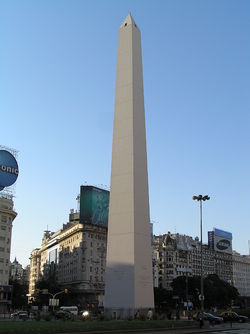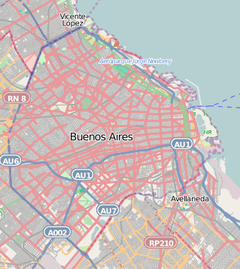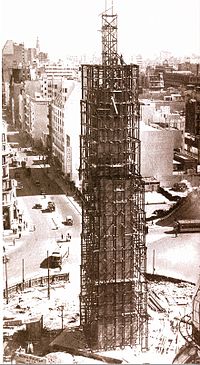- Obelisk of Buenos Aires
-
Obelisco de Buenos Aires Location: San Nicolás, Buenos Aires, Argentina Coordinates: 34°36′13″S 58°22′54″W / 34.60361°S 58.38167°WCoordinates: 34°36′13″S 58°22′54″W / 34.60361°S 58.38167°W Elevation: 67.5 meters Built: May 23, 1936 Built for: Monument Restored: 2005 Architect: Alberto Prebisch National Historic Monument of Argentina The Obelisk of Buenos Aires (Spanish: Obelisco de Buenos Aires) is a national historic monument and icon of Buenos Aires. Located in the Plaza de la República, in the intersection of avenues Corrientes and 9 de Julio, it was built to commemorate the fourth centenary of the first foundation of the city.
In order to enrich the surroundings of the iconic monument, the government of the city started the project Punto Obelisco. Creating a zone full of LED signs. Since the Obelisk of the city is always associated with the night and entertainment of Buenos Aires, this project creates a zone similar to Times Square in New York and Picadilly Circus in London.
Contents
History
Construction began on March 20, 1936 and was inaugurated on May 23 of the same year. It was designed by architect Alberto Prebisch (one of the main architects of the Argentine modernism who also designed the Teatro Gran Rex, in Corrientes and Suipacha) at the request of the mayor Mariano de Vedia y Mitre (appointed by president Agustín Pedro Justo). For its construction, which cost 200,000 pesos moneda nacional, 680 m³ of concrete and 1360 m² of Olaen white stone from Córdoba were used.
The obelisk was built by the German company G.E.O.P.E. - Siemens Bauunion - Grün & Bilfinger, which completed its work in a record time of 31 days, with 157 workers. The rapid hardening Incor cement was used and was built in sections of 2 meters to facilitate the dumping of concrete.
Its height is 67.5 m, and 63 m of these are up to the initiation of the apex, which is 3.5 m by 3.5 m. The tip is blunt, measuring 40 cm and ends in a lightning rod that can not be seen because of the height, whose cables run through the interior of the obelisk.
It has only one entrance (in its west side) and on its top there are four windows, that can only be reached by a straight staircase of 206 steps with 7 breaks every 8–6 m.
On February 20, 1938, Roberto María Ortiz succeeded Justo and appointed Arturo Goyenche as the new mayor of the city. In June 1939 the City Council sanctioned the demolition of the Obelisco, citing economic, aesthetic and public safety reasons. However, the ordinance was vetoed by the municipal executive power, characterizing it as an act lacking of value and juridical content, because it alters the state of things emanated by the executive power, and that it was a monument under the jurisdiction and custody of the Nation whose heritage belongs to it.
Where the Obelisco stands, a church dedicated to St. Nicholas of Bari was previously demolished. In that church the Argentine flag was officially hoisted for the first time in Buenos Aires, 1812. That fact is noted in one of the inscriptions on the north side of the monument.
As a result of some detachments of stone cladding, which occurred on the night of June 20-21, 1938, the day after a public event with the presence of president Ortiz took place there, it was decided to remove such cladding in 1943 and was replaced by another one made of polished cement, making cracks to simulate the joints of the stones. When the slabs were removed, a lenged that said <<Its arquitect was Alberto Prebisch>> was also removed.
For some time during the 1970s, during the Peronist government of Isabel Martínez de Perón, a ring-shaped sign was hung around the obelisk, with the motto El silencio es salud (Silence is health). Although it was allegedly geared against motorists creating excessive noise, it was widely interpreted as a statement calling Argentines to refrain from expressing their political views.
Throughout its history, the monument has suffered vandalism, especially politically-oriented graffiti. In the 1980s, an activist group broke in and spilled paint from the top windows, causing the city government to erect a fence around its base. This move stirred controversy, but eventually proved effective in reducing the number of defacing incidents.
On 1 November 2005 it was announced[1] that a comprehensive restoration, financed by the Argentine painting and restoration industry association (Ceprara), was finished. The monument was painted with 90-micrometre acrylic paint to a "Paris stone" hue, deemed more pleasant than the previously used white.
On December 1, 2005, the obelisk was covered by a giant pink "condom" to commemorate the World AIDS day.[2]
To commemorate the 30th anniversary of the La Noche de los Lápices, the monument was converted into a giant pencil.[3]
Lines B, C, and D of the Buenos Aires Metro have stations near the monument, and are connected by a number of underground passages with commercial galleries.
Inscriptions on its sides
North side West side South side East side Poem 



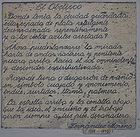
English:
On this site
in the St. Nicholas tower
the National Flag
was hoisted for the first time
in the city
the XXIII of August of
MDCCCXII.English:
Capital Federal
Ley enacted by the National Congress
the XX of September of MDCCCLXXX
initiative of the President
Nicolás Avellaneda
Decree of the President Julio A. Roca
VI of December of MDCCCLXXX.English:
Second Foundation by
Juan de Garay
XI of June of MDLXXX.English:
Buenos Aires
to the Republic
In the IV centenary of the foundation
of the city by
Don Pedro de Mendoza.
II of February of MDXXXVI.Poem by Baldomero Fernández Moreno inscribed on the south side. On the side facing south, in its base in a very small rectangle, this sonnet written by Baldomero Fernández Moreno during a tribute dinner in the Alvear Palace Hotel to Prebisch:
-
-
-
- El Obelisco
-
-
-
-
-
- ¿Donde tenía la ciudad guardada
- esta espada de plata refulgente
- desenvainada repentinamente
- y a los cielos azules asestada?
-
-
-
-
-
- Ahora puede lanzarse la mirada
- harta de andar rastrera y penitente
- piedra arriba hacia el Sol omnipotente
- y descender espiritualizada.
-
-
-
-
-
- Rayo de luna o desgarrón de viento
- en símbolo cuajado y monumento
- índice, surtidor, llama, palmera.
-
-
-
-
-
- La estrella arriba y la centella abajo,
- que la idea, el ensueño y el trabajo
- giren a tus pies, devanadera.
-
-
Special occasions
December 1, 2005 September 20, 2007 May 23, 2010 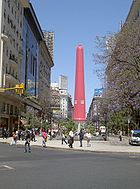
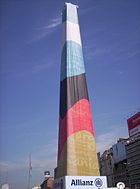
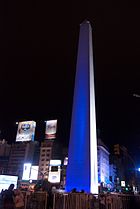
A giant condom on El Obelisco (for World AIDS Day) El Obelisco covered with the colors of Argentina and Germany, celebrating 150 years of bilateral relations between these countries El Obelisco celebrating the Argentina Bicentennial References
- ^ La Nación
- ^ Buenos Aires' obelisk wears pink condom for World AIDS Day. Agence France-Presse, December 1, 2005.
- ^ La Nación
- http://otrosmovil.clarin.com/ciudades/capital_federal/Luces-colores-cambian-entorno-Obelisco_0_271772976.html
- http://bsas.gov.ar/areas/med_ambiente/obelisco_01.php
External links
- (Spanish) Article on restoration
- Google Maps
Categories:- 1936 architecture
- Buildings and structures in Buenos Aires
- National Historic Monuments of Argentina
- Obelisks in Argentina
- Terminating vistas
- Visitor attractions in Buenos Aires
-
Wikimedia Foundation. 2010.

